One Night Ultimate Werewolf – is one night enough?
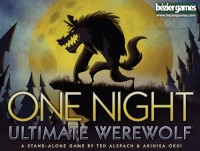
Is one night enough to track down werewolves roaming around the village?
Well, in One Night Ultimate Werewolf that’s all the time you’ve got. So you better make it count.
For those unfamiliar with Werewolf (or as some people know it – Mafia), it’s a social deduction game for a large group of people. In the game players take on the roles of werewolf or villager (or seer – a special villager) and over the course of a number of night and day phases, players try to deduce who the werewolf or werewolves are.
At night, the Werewolves secretly choose a Villager to kill. During the day, the Villager who was killed is revealed and is out of the game. The remaining Villagers then vote on the player they suspect is a Werewolf. That player is “lynched”, reveals his/her role, and is out of the game. Werewolves win when there are an equal number of Villagers and Werewolves. Villagers win when they’ve killed all Werewolves.
Werewolf came out decades ago and has since seen a number of iterations. A number of years ago, Ultimate Werewolf introduced a wide variety of different villager roles that added a bunch of flavor and mixed up the social deduction even more.
The biggest downside to Werewolf is the player elimination. Once you’re ‘killed’ or ‘lynched’, you’re out of the game and have to just sit on the sidelines while everyone else has a great time bluffing, pointing fingers, and trying to figure out who the werewolves are.
So when One Night Ultimate Werewolf was released by Bezier Games this year with the promise of no player elimination and only 10 minutes of game time, we were very anxious to play it.
How to Play One Night Ultimate Werewolf
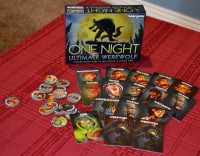
Just like it’s predecessor, in One Night Ultimate Werewolf each player takes on the role of Villager, Werewolf, or a special Villager Role. The Villager team wants to take down at least one Werewolf to win and the Werewolf team wins if no Werewolves die.
But the biggest differences are that there’s only one night phase and no one dies.
Werewolves also don’t attack anyone during the night, so there’s no death in the morning to help in the deduction. However, there’s still a number of things that can happen during the night because of the special village characters.
Set Up:
As expected, set up is different depending on the number of players (# of villagers, etc.). To start, each player randomly, and secretly, gets a Role card and 3 additional Role cards are placed face-down in the center of the table. Each player looks at their card and then places it face-down on the table in front of them as well. (All Role cards should be in reach of all players.)
Night:
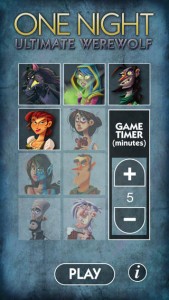
During the night phase, players close their eyes while several Roles are called out to do their special actions. The order in which the Roles take there action is important. So either one person calls out the Roles in that order, or you can use the super handy-dandy app.
Our personal opinion is that we’ll never play without the free app. It’s fabulous!
Simply tap on the Roles that you’re playing with and the announcer will run through them in the right order – in a terrific announcer voice and with awesome mood-inducing background noise. The app also includes a timer for the day (discussion) phase.
Day:
Once the short night phase is over, day breaks and players discuss who they believe the Werewolves are. The only rule for the day phase is that players cannot show their Role cards. Players can say and claim whatever they’d like, but they just can’t show their card to anyone.
Vote:
Once the daytime discussion is up, players vote on who to lynch.
Simply count down then players simultaneously point at who they’d like to lynch. Whoever gets the most votes dies and reveals his/her card. If it’s a tie, both players die. If at least one Werewolf dies (or there are no werewolves due to both werewolf cards being in the center of the table), then the Village team wins. If all werewolves survive, the Werewolf team wins.
It’s that simple.
But it’s not.
What’s the catch?
The catch with One Night Ultimate Werewolf is that when day comes you might not be who you think you are!
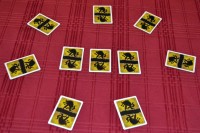
You may spend the night as a peaceful villager and in the morning (after the lynching) find out that you’ve turned into a werewolf. You’ll only find out after the lynching because players can’t look at their card during the day.
It’s the special villager roles in the game that make it fun. And some of the roles switch things around during the night.
One Night Ultimate Werewolf plays 3 to 10 players so not all roles will be in every game. For example, with 3 players, only 6 cards will be in the game and 2 of those will be werewolves. It’s fun to see how playing with a different combinations of roles will mix up the discussions and outcome.
Here are the roles in the order in which they wake up at night to do their actions:
- Doppelganger – (only play with this once familiar with other roles) looks at one other player’s card and does something depending on what he/she sees. (See below after reading other roles.)
- Werewolf – all werewolves open their eyes and look for other werewolves.
- Minion – is on the werewolf team and opens his eyes to see who the werewolves are by their thumb being up. Werewolves don’t get to see who the Minion is.
- Mason – is on the village team and there will always be 2 (when in the game). They wake up at night to see each other (or see no one if the other card is in the center).
- Seer – is on the village team and may look at another player’s card or at 2 in the center.
- Robber – may choose to rob a card from another player and replace it with his card (looking at his new card). The Robber is on the team of the card he takes or on the village team if he chooses not to take a card.
- Troublemaker – is on the village team and during the night can switch the cards of two other players (without looking at them).
- Drunk – so drunk he doesn’t remember his role. When he wakes up, he simply exchanges his card for one of the cards in the center of the table (without looking at it) and is on that team.
- Insomniac – is on the village team and wakes up in the night to look at his/her own card (to see if the role has changed).
- Villager – is on the village team and has no special abilities and remains asleep all night. Of course, during the day players may want to claim to be a villager…
- Tanner – is not on either team and hates his job so much he wants to die. He only wins if he dies. If the Tanner dies and no werewolves die, the werewolves don’t win, the Tanner does. If a werewolf also dies along with the Tanner, both the Tanner and the Village team win. He also stays asleep all night.
- Hunter – is on the village team and if he dies, the player he was pointing at also dies. He’s another role that stays asleep all night.
Now back to the Doppleganger. When woken up at night he/she may see:
- Villager, Tanner, or Hunter, he is now that role and does nothing else at night.
- Werewolf or Mason, he wakes up with those roles and is on the werewolf team if he views a werewolf and village team if he views a Mason.
- Seer, Robber, Troublemaker, or Drunk, he immediately does that role’s action (keeps eyes closed when those roles are called later).
- Minion – if a minion is in the game the announcer will say to close eyes unless Doppelganger is now the minion and will have the werewolves put their thumbs up. He’s then on the werewolf team.
- Insomniac – after the real Insomniac wakes up, the Doppelganger-Insomniac will wake up and do the Insomniac role.
So as you can see – the special cards can add quite a twist to the game.
After all, if the werewolf isn’t killing someone during the night it’s great to have other roles taking nighttime actions to help feed the discussion and deduction once day comes.
Great Art and Components
While we’ve used the term “card” throughout our review, in reality the roles aren’t on typical playing card stock. Instead they’re more like boards – hearty components that eliminate the risk of accidental bending or being marked like typical cards.
The sturdy nature of the Role markers (‘cards’) are also a lot easier to pick up off the table – which is critical for some of the roles during the night. For example, with a limited amount of time for the Troublemaker to switch cards, he needs to grab and move them quickly. These boards are easy to do that with vs. trying to pick up a playing card.
And we love the art style. It’s a perfect fit to the nature of the game.
Our impression of One Night Ultimate Werewolf
The first time we played the One Night Ultimate Werewolf, when the day phase came we weren’t quite sure what to do. The night phase (with the awesome app narration) went by very smoothly in just a couple minutes. We all opened our eyes and then just kind of stared at each other and shrugged our shoulders. A few comments were made then we went right into pointing fingers without much to go on.
Cards were then revealed and we saw who the werewolves were.
Then we questioned – “that’s it?”
Very short. Very simple. But not very entertaining.
But of course, since the game was so quick, we switched in a few different roles and tried it again.
This time the discussion had a bit more to go on and the outcome brought some surprises as players flipped over their cards. The person lynched, who had been claiming innocence was in fact a werewolf. Villagers win!
Of course, he hadn’t been a werewolf when night began, but thanks to the Troublemaker he turned into a werewolf during the night. Go Troublemaker!
Now we had a game.
That unexpected twist brought some life to the game and we immediately went at it again.
And again.
And again…
It turns out that we ended up playing One Night Ultimate Werewolf for an hour.
With a short under-10 minute play time, it’s so easy to grab new roles, deal the cards, close your eyes and go again that we had to play multiple times.
And we’d venture to guess that you’ll do the same.
No way will One Night Ultimate Werewolf be contained to just one night.
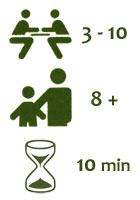 How does One Night Ultimate Werewolf score on our “Let’s Play Again” game meter?
How does One Night Ultimate Werewolf score on our “Let’s Play Again” game meter?
Like we just mentioned, one play (one “night”) just isn’t enough for One Night Ultimate Werewolf. Playing back-to-back games adds to the enjoyment. With different roles to choose from, there’s a lot of possibilities. Some are funner to have together than others, but all add some type of twist.
So far we haven’t pulled it out for Guys Game Night (when dad’s buddies come over to play), but we’re expecting multiple games in a row as well. And just as with other social deduction games, the dynamics change depending on who and how many players are playing. The dynamics also change with repeated plays in a row.
We’ve had a great time with social deduction games as a Guys Game Group, so we’re looking forward to playing One Night Ultimate Werewolf with them as soon as we can.
Thanks Bezier Games for a fun social deduction and party game.
| The Board Game Family Game Ratings | |
| Caleb | |
| Brooke | |
| Jaden | |
| Trevor | |
| Mom | |
| Dad | |
| Average | |

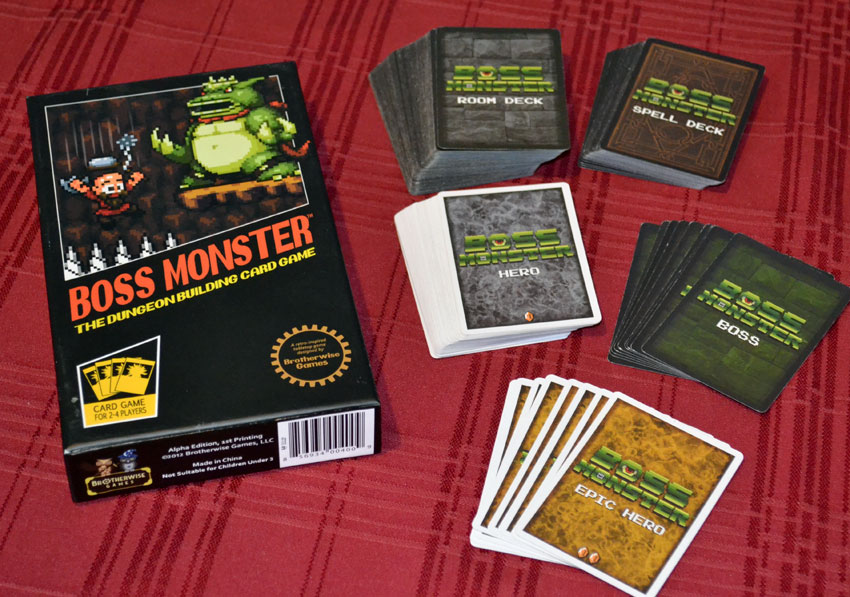
Great review! I failed to see what would be intriguing about this game in scanning through the rules. You opened my eyes. Thanks!
Jonathan – glad to hear our review was helpful in taking a deeper look at the game.
“””Tanner – is not on either team and hates his job so much he wants to die. He only wins if he dies. If the Tanner dies and no werewolves die, the werewolves don’t win, the Tanner does. If a werewolf also dies along with the Tanner, both the Tanner and the Village team win. He also stays asleep all night.”””
Is it possible that the Tanner dies AND ALSO a Werewolf? I don’t see how that could happen. The only way two players can die is if one of them is the hunter, right? So if the Tanner dies EVERYBODY else loose, right?
If there is a voting tie between two (or three) players they are both lynched, so then it is possible for both a Tanner and a Werewolf to die. I had totally forgotten that tied votes is an option.